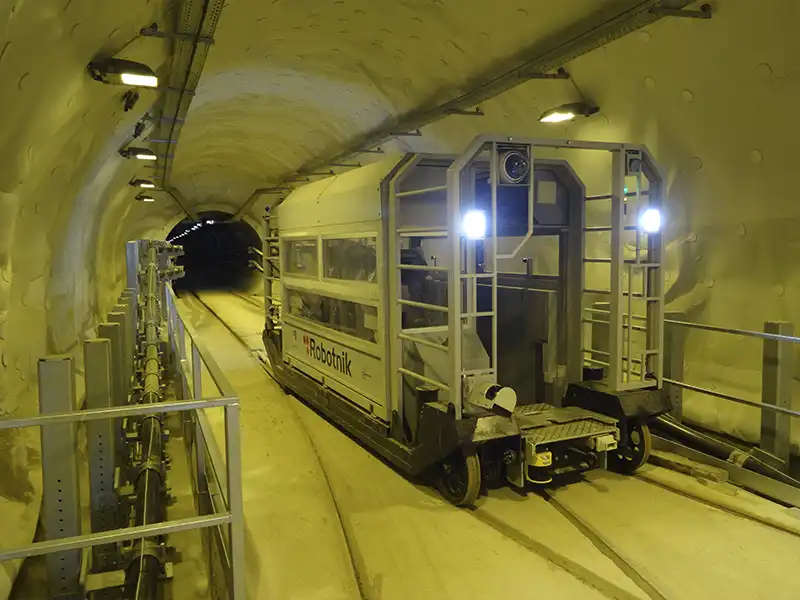The magazine AEM – Asociación Española de Mantenimiento, publishes this article by Raúl Sebastiá, Director of the Engineering Department at Robotnik. The article shows a vision of robotics for maintenance and industrial surveillance, technological framework and real use cases of mobile robots performing inspection and maintenance tasks in different sectors.
Autonomous Mobile Robots: A Boost for Industrial Surveillance and Maintenance
Author: Raúl Sebastiá. Director of the Engineering Department at Robotnik.
INTRODUCTION
In the fourth industrial revolution, new technologies play a key role in strengthening the maintenance, security and surveillance sectors. Security in industrial facilities, surveillance of different areas, monitoring of critical infrastructures or predictive maintenance are a priority for organizations of all sizes and sectors.
These sectors currently face significant difficulties in finding qualified personnel due to the fact that this type of task involves risks for workers, and are often carried out in adverse weather conditions at variable and complex schedules.
Automating maintenance and surveillance tasks using autonomous mobile robots (AMRs) represents a disruptive solution to improve the quality of services (even in hard-to-reach locations), reduce costs, prevent and minimize risks or increase personnel safety.
This article provides an overview of inspection robotics, frequent applications and state of development technology.
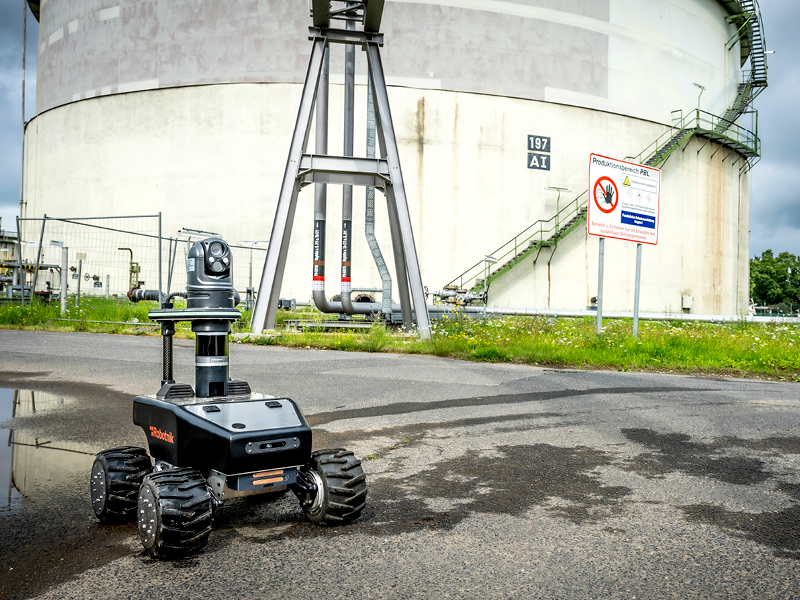
INSPECTION ROBOTICS MARKET OVERVIEW
Inspection and Maintenance robotics are increasing by approximately 20% every year. This growth is due to market demand and significant technological evolution in recent years.
From a sociological perspective, this is an area in which the needs of the market demand a much higher pace than the regulatory reality. This has led to the technology at the service of inspection tasks being at a much more advanced point than the current regulations.
Tasks related to surveillance or maintenance are historically based on human presence for operations such as patrolling delimited areas, monitoring irregularities or responding to incidents. However, human teams present limits to physical endurance such as fatigue, decreased attention span or the complexity of operating in certain hostile environments such as areas with harmful chemicals.
AMRs emerge in this context as a solution to complement and enhance the work of the human team, offering a series of benefits:
-
- Efficiency: AMRs can patrol large areas consistently and accurately regardless of weather conditions or other adverse environmental factors.
- Increase occupational safety: reduce personnel exposure to hazardous situations, improving working conditions and reducing the risk of injury.
- Data collection: robots can record and process accurate data, including images and videos, becoming an invaluable tool for further investigations, legal testing, or implementation of improvements in security protocols.
At the same time, challenges such as cybersecurity or the regulations and legislation governing the use of autonomous robots are emerging, being some of the most conflictive areas and the focus of attention of engineers, researchers, professionals in the technology sector and public regulatory institutions.
1. FRAMEWORKS FOR RESEARCH AND TECHNOLOGICAL INNOVATION OF INSPECTION ROBOTS
The European Union has initiated a series of actions aimed at addressing the challenges in the security industry through different fields of research and initiatives that promote the achievement of a collective response capable of fostering a framework of competences. Particular attention is paid to ensuring that the innovative technologies and solutions derived from these security initiatives fully respect ethical concerns and guarantee fundamental rights in sensitive areas such as Artificial Intelligence or biometrics.
The European Union’s research and innovation pathways for the period 2021 – 2027 are embodied in the Horizon Europe programme, which has 1,600 million euros for research projects in civil security.
These projects allow companies, manufacturers, technological institutes and universities to develop solutions that bridge the gap between research and the market. This has been the case with mobile robotics for Inspection and Maintenance, which in recent years has reached an unprecedented technological level.
Ángel Soriano, Robotnik’s R&D Manager, explains that
“Mobile robotics has become an invaluable tool for the industrial inspection of aging civil infrastructures such as bridges, tunnels or roads, contributing to their safety and preventive maintenance. Such is the example of Piloting, a Horizon Europe project that sets up large-scale pilots in real civil engineering environments to directly respond to major I&M challenges in deteriorated refineries, bridges/viaducts and tunnels.
HERON is another of the European projects in which we are working to develop an automated system that performs road maintenance and improvement tasks such as the crack sealing, the patching of potholes, pavement renewal, autonomous replacement of CUD elements or the painting of markings. Regarding the industrial inspection of hazardous areas, I can highlight INMERBOT, a project in which Robotnik is developing an autonomous robotic solution capable of carrying out inspection and maintenance tasks in highly immersive environments by integrating haptic technologies, robotics, advanced sensors, artificial intelligence and reconstruction of the environment from data from sensors and vision cameras. Our participation for more than 20 years in R&D projects has allowed us to develop and demonstrate mobile robotics systems in real scenarios with the corresponding trial-and-error tests. The result of these projects is a portfolio of robust robots such as the RB-WATCHER that we recently launched on the market.”
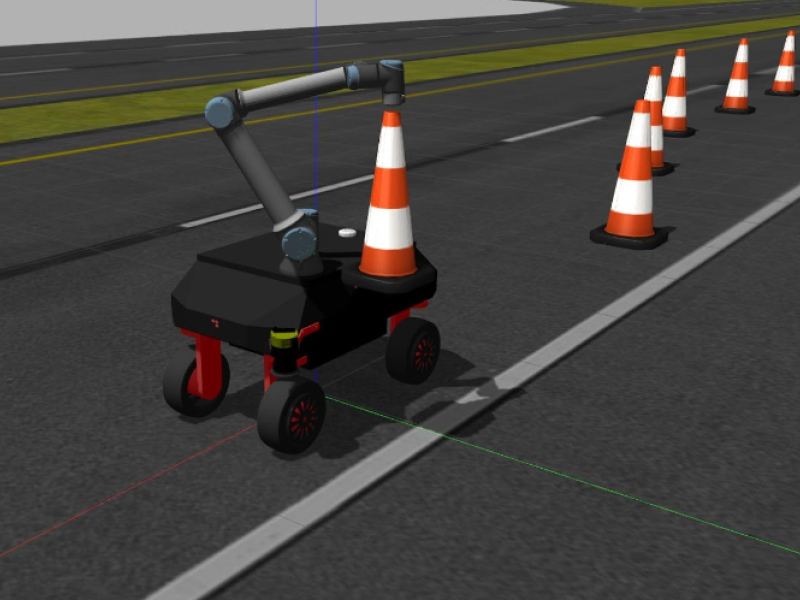
2. INSPECTION ROBOT: PERCEPTION AND ENVIRONMENT
Inspection and Maintenance robots require specific sensorization, whose configuration may vary depending on the needs of the final application. An example of this is Robotnik’s RB-WATCHER. This mobile robot has been developed to carry out inspection and surveillance tasks in any indoor or outdoor space, including hard-to-reach areas or under adverse weather conditions. This solution aims to overcome the limitations of static surveillance camera circuits in terms of range, flexibility and speed of response. It is capable of navigating and moving autonomously or remotely through location based on 3D SLAM and GPS, avoiding static or dynamic obstacles that may appear on its route and reporting data in real time to the control center for later analysis.
This surveillance robot incorporates advanced technology such as image recognition software or a series of specific sensors: front depth camera, motion sensors, thermal camera, Bispectral Pan-Tilt-Zoom camera, microphone to capture ambient sounds and speakers for the communication of instructions, as well as detection modules for the identification of people, fires, vehicles or suspicious objects.
Constant and accurate monitoring of the environment allows for a quick response thanks to the transmission of alerts to the control center via email, telegram or other messaging protocols such as REST or MQTT.
Autonomous mobile robotics offers a comprehensive approach to Inspection and Maintenance in which multisensory perception is essential, both for basic functionalities (inertial sensors, encoders or proximity sensors) and for advanced functions (thermal cameras or 3D Lidar), which achieve improved reality capture and combine with algorithms, Artificial Intelligence or Machine Learning to analyze the environment in greater depth and provide more accurate answers. Smart.
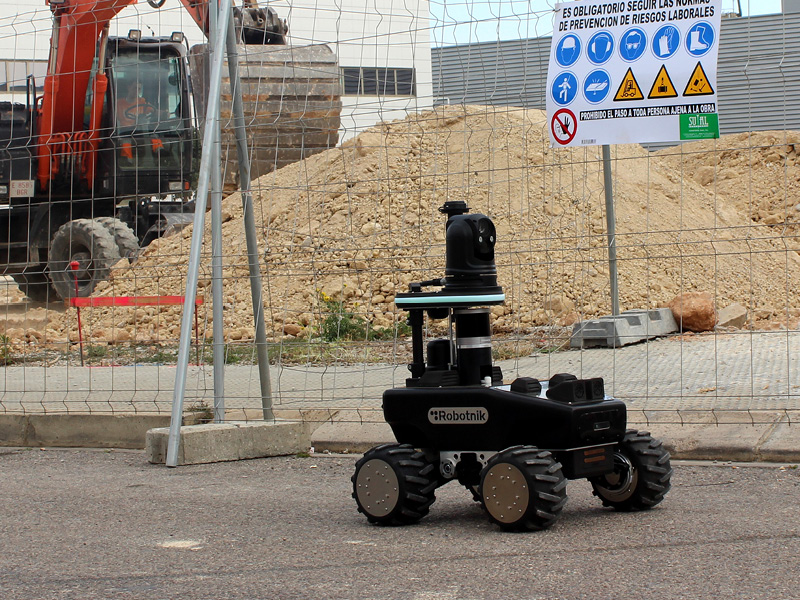
3. REAL-WORLD APPLICATIONS OF INDUSTRIAL INSPECTION AND MAINTENANCE ROBOTICS
Within industrial production, a distinction can be made between quality inspection and perimeter inspection. As for the former, robots or mobile manipulators equipped with artificial vision systems and high-precision sensors can carry out exhaustive quality controls of machinery, parts or products, detecting faults and minimal variations. Perimeter inspection refers to the monitoring of infrastructure to ensure the security of the infrastructure by minimizing human error, recording data reliably, and avoiding incidents and irregularities that entail considerable economic and human costs.
INSPECTION AND MAINTENANCE USE CASES
In the energy industry, robots play a crucial role in the inspection and maintenance of facilities such as power plants or critical infrastructures such as electrical substations where the robot patrols high-voltage areas, minimizing the risk to personnel and providing continuous surveillance that detects in real time any irregularities or failures in the system, and analyzing the information collected to transmit alerts if necessary. Surveillance robots such as the aforementioned RB-WATCHER are increasingly being used in industrial environments to monitor critical infrastructures to detect leaks, overheating and unauthorized access in factories and power plants.
An example of industrial maintenance of critical infrastructures is the case of the inspection robot deployed in the electrical substation of the Spanish energy company EDP to optimize its maintenance. For this application, Robotnik’s mobile robot performs tasks of monitoring, patrolling, overheating detection, alarm transmission, navigation and collecting high-quality data that is communicated in real time to the relevant personnel.
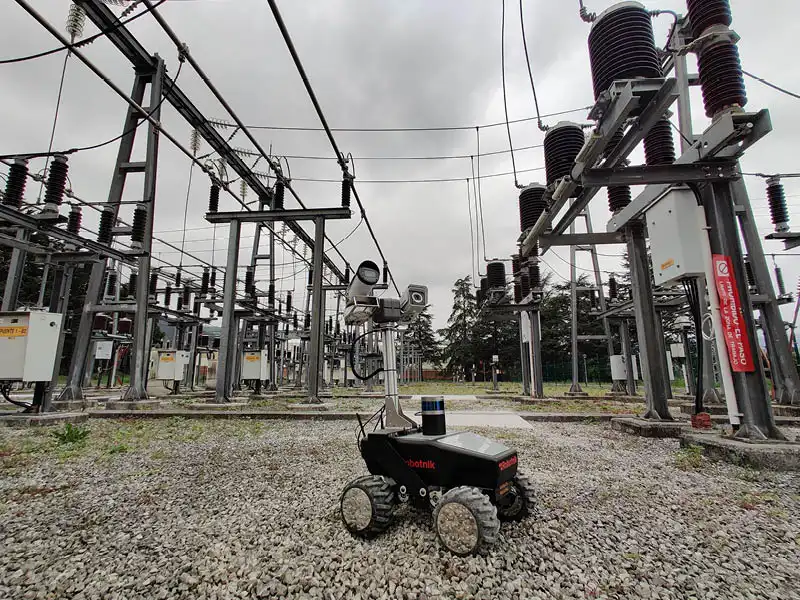
Another use case is the fleet of robotic trains, developed by Robotnik, aimed at monitoring the good condition of the tunnel section of the line in order to provide safety and reliability to the high-voltage power line between France and Spain.
The line is 64.5 kilometers long, 33.5 in France and 31 in Spain, and crosses the Pyrenees through an 8.5-kilometre tunnel in the central part of the route. This is an ambitious European project developed by the mixed capital company INELFE (acronym for France-Spain Electricity Interconnection, a company formed by the public electricity companies of each country). The objectives of the interconnection between the two countries are to optimize the daily production of power plants, increase opportunities to operate with renewable energies and improve supply conditions.
The robot operates autonomously without requiring human intervention for inspection tasks. The vehicle incorporates advanced sensors -vision cameras, thermal imaging cameras or gas sensors, for example- that provides information on the state of the facilities inside the tunnel, supervising the safety and reliability of this high-voltage power line and the good condition of the infrastructure.
The evolution of technologies such as Artificial Intelligence, Artificial Vision, 5G or data science extend the operational limits of autonomous mobile robotics so that it executes tasks not only mechanically, but intelligently.
As they progress, the range of Inspection and Maintenance tasks that they can carry out autonomously will expand and new scenarios will also emerge that require security robots, which will patrol autonomously both in corporate facilities and, in some countries, in public spaces.
